商务英语marketing市场营销
商务英语专业术语词汇及解释_解释说明
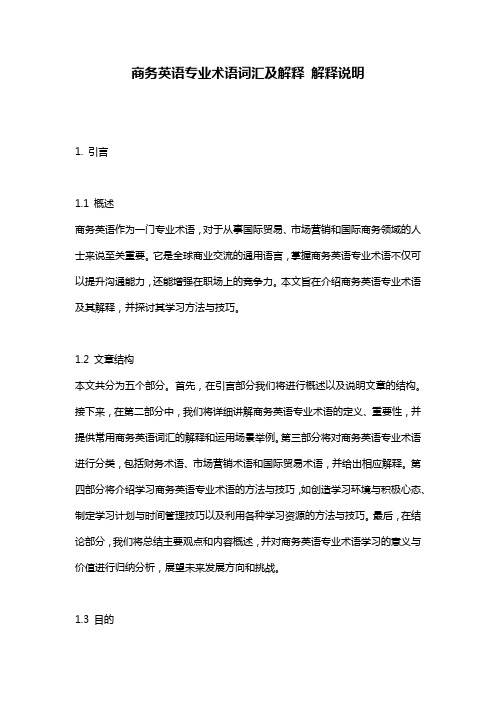
商务英语专业术语词汇及解释解释说明1. 引言1.1 概述商务英语作为一门专业术语,对于从事国际贸易、市场营销和国际商务领域的人士来说至关重要。
它是全球商业交流的通用语言,掌握商务英语专业术语不仅可以提升沟通能力,还能增强在职场上的竞争力。
本文旨在介绍商务英语专业术语及其解释,并探讨其学习方法与技巧。
1.2 文章结构本文共分为五个部分。
首先,在引言部分我们将进行概述以及说明文章的结构。
接下来,在第二部分中,我们将详细讲解商务英语专业术语的定义、重要性,并提供常用商务英语词汇的解释和运用场景举例。
第三部分将对商务英语专业术语进行分类,包括财务术语、市场营销术语和国际贸易术语,并给出相应解释。
第四部分将介绍学习商务英语专业术语的方法与技巧,如创造学习环境与积极心态、制定学习计划与时间管理技巧以及利用各种学习资源的方法与技巧。
最后,在结论部分,我们将总结主要观点和内容概述,并对商务英语专业术语学习的意义与价值进行归纳分析,展望未来发展方向和挑战。
1.3 目的本文的目的是帮助读者全面了解商务英语专业术语,并提供有效的学习方法与技巧。
通过阅读本文,读者将能够掌握商务英语专业术语的基本知识、运用场景以及分类,进而提升自己在商务领域中的交流能力和竞争力。
同时,本文还旨在引发对商务英语专业术语学习的意义和价值的思考,并为未来学习提供指导。
2. 商务英语专业术语词汇及解释:2.1 定义和重要性:商务英语专业术语是在商务活动中频繁使用的特定词汇或短语,它们具有行业性质,用于描述商务交流、谈判、合作等方面的内容。
掌握并正确运用商务英语专业术语对于进行国际商务往来、开展跨国合作具有重要意义。
良好的商务英语能力将帮助我们更好地与国际伙伴交流、了解相关行业知识,并有效推动商业活动。
2.2 常用商务英语词汇解释:在这部分中,我们将介绍一些常用的商务英语词汇及其解释。
1) Marketing(市场营销)- 指通过市场调研、广告宣传和销售策略等手段来推广产品或服务的过程。
商务英语阅读-unit-9-Marketing
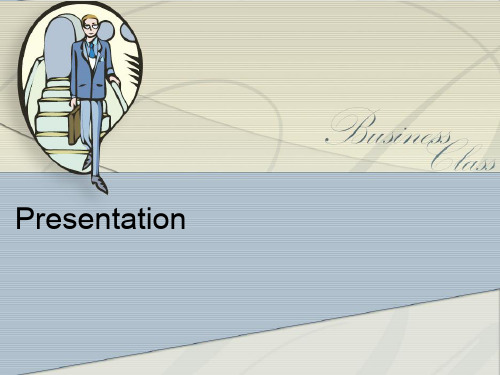
• Transport V-T. To transport people or goods somewhere is to take them from one place to another in a vehicle. 运送
• e.g. Railway lines that transport the coal to ports for export have also been flooded.
,并继续下去的动作。一般用延续性动词表示
• Para. 2 We are looking for Agents/ Distributors with experience selling products within the bedding industry. A representative of the company will be visiting the United States at the end of July.
• 消费50美元可获得一张 抽奖券,并有机会从种 类丰富的电子产品中赢 取一款
2. Agent/ Distributors
• 代理商/经销商
• Please translate the following sentences in the text. (Individual work)
• 1)para. 1 • Leading manufacturer • 主要生产商,业内领先的制造商 • Exporting to …. 思考下这两个现在分词的作用 • 现在分词分别做前置定语和后置定语。 • 翻译:本公司是澳大利亚纯正新世纪品牌被子、枕
• 翻译: • 我们寻找床上用品业内有经验的代理商或经销商加盟
。本公司将派代表在7月底访美。
商务英语四级术语翻译
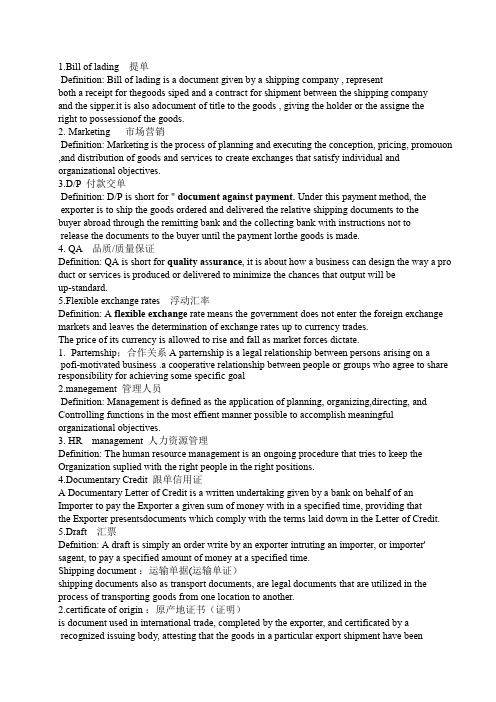
1.Bill of lading 提单Definition:Bill of lading is a document given by a shipping company,representboth a receipt for thegoods siped and a contract for shipment between the shipping companyand the sipper.it is also adocument of title to the goods,giving the holder or the assigne theright to possessionof the goods.2.Marketing 市场营销Definition:Marketing is the process of planning and executing the conception,pricing,promouon ,and distribution of goods and services to create exchanges that satisfy individual and organizational objectives.3.D/P 付款交单Definition:D/P is short for"document against payment.Under this payment method,the exporter is to ship the goods ordered and delivered the relative shipping documents to thebuyer abroad through the remitting bank and the collecting bank with instructions not torelease the documents to the buyer until the payment lorthe goods is made.4.QA 品质/质量保证Definition:QA is short for quality assurance,it is about how a business can design the way a pro duct or services is produced or delivered to minimize the chances that output will beup-standard.5.Flexible exchange rates 浮动汇率Definition:A flexible exchange rate means the government does not enter the foreign exchange markets and leaves the determination of exchange rates up to currency trades.The price of its currency is allowed to rise and fall as market forces dictate.1.Parternship;合作关系A parternship is a legal relationship between persons arising on apofi-motivated business.a cooperative relationship between people or groups who agree to share responsibility for achieving some specific goal2.manegement 管理人员Definition:Management is defined as the application of planning,organizing,directing,and Controlling functions in the most effient manner possible to accomplish meaningful organizational objectives.3.HR management 人力资源管理Definition:The human resource management is an ongoing procedure that tries to keep the Organization suplied with the right people in the right positions.4.Documentary Credit 跟单信用证A Documentary Letter of Credit is a written undertaking given by a bank on behalf of an Importer to pay the Exporter a given sum of money with in a specified time,providing thatthe Exporter presentsdocuments which comply with the terms laid down in the Letter of Credit. 5.Draft 汇票Defnition:A draft is simply an order write by an exporter intruting an importer,or importer' sagent,to pay a specified amount of money at a specified time.Shipping document:运输单据(运输单证)shipping documents also as transport documents,are legal documents that are utilized in the process of transporting goods from one location to another.2.certificate of origin:原产地证书(证明)is document used in international trade,completed by the exporter,and certificated by a recognized issuing body,attesting that the goods in a particular export shipment have beenproduced,manufactured or processed in a particular country.3.insurance policy:保单(保险合同/大保单)is a formal contract-document between the insurer and the insured,known as the policy holder, which determines the claims which the insurer is legally required to pay.5.customer equity:顾客资产is the value of potential future revenue generated by a company's customers in a lifetime.l.sole/individual proprietorship:独资经营Detnition:It is a type of enterprise that is owned and run by one natural person.The owner is in Direct control of all elements and is legally accountable for the finances of such business and this may include debts,loans,loss,etc.2.Productivity:生产力It is the rate at which goods are produced.(or having thẻpower to produce)3.broker:代理/中介:A broker is a person whose job is to buy and sell shares,foreign money,or goods for other people.4.Fixed assets:固定资产are assets which a company uses on a continuous basis,such as properly and machinery.5.Cash on delivery:货到付款Collecting the charges upon delivery.1.anti-dumping duty:反倾销税is an extra duty levied temporarily on the imported commodity in dumping to protect home industry and market against the import commodity in large quantity and cheap price.2.Transnational corporation跨国公司refers to large international enterprise consisting of entities in two ormore countries,that operates manufacturing,sales and other business.3.Invisible trade:无形贸易trade of services rather than actual goods,for example,banking,insurance,and professional service,etc.4.Balance of payment:国际收支A statement that summarizes an economy's transactions with the rest of the world for a specified time period.1.CPI,消费价格指数消费物价指数Consumer price index measures changes in the price level of market basket of consumer goods and services purchased by households.2.LLC, 有限责任公司Limited liability company a business structure that combines the pass-through taxation of apartner ship or sole proprietorship with the limited liability of a corporation.3.FOB,离岸价格/船上交货价格Free On Board is a shipping term which indicates that the supplier pays the shipping costs(and usually also the insurance costs)from the point of manufacture to a specified destination,at Which point the buyer takes responsibility.4.B2B,企业对企业的电子商务模式Business-To-Business is a transaction that occurs between two companies,as opposed to a transaction involving a consumer.The term may also describe a company that provides goods or s ervices for another company.5.Definition:借记卡/提款卡Debit card is a card which allows customers to access their funds immediately electronically.With a debit card,you can immediately take money out of your checking account either through purcha ses at a store or through an ATM.1.A CEO首席执行官(chief executive fficer)is the position of the most senior corporate officer,executive,leader or administrator in charge of managing an organization.2.Human resource:人力资源In a company or other organization,the department of human resources is the department take on ponsibility for the recruiting,training,and welfare of the staff.bor market劳动力市场is the market in which workers compete for jobs and employers compete for workers.3.V AT增值税(value added tax)is a tax that is added to the price of goods or services.4.A balance sheet is a written statement of the amount of money and property that a company op erson has,including amounts of money that are owed or are owing.资产负债表5.Brand loyalty 品牌忠诚:The tendency to always buy a particular brand.2.Joint venture合资公司A business activity in which2or more companies have invested together.3.Quota:定额Quanttative restrictions imposed by one country on imports of a certain type from another country.4.marketing mix:营销组合A comprehensive plan or strategy covering product price,promotion and place,usually summarized as the4Ps".of marketing.5.Acqusition :收购Getting control of a company bitiony buying over50%of its shares. Definition:Lredit card is a small plastic card that you can use to buy goods and services and pay for the market.2.Depeciatiton贬值means decrease in value of assets.3.Brand preference品牌偏好is measure of brand loyalty in which a consumer will choose a paticular brand in presence of competing brands,but will accept substitutes if that brand is not available.4.Corporate Culture公司文化is a broad term used to define the unique personality or character of a particularcompany or organization,and includes such elements as core values and beliefs,corporate ethics,and rules of behavior.5.:Fringe benefit额外福利is an incidental or additional advantage,a benefit provided by an employer to supplement an employee's regular pay,such as a pension,company car,luncheon voucher,insurance,vacation 1.overcapacity:生产能力过剩If there is overcapacity in a particularindustry, more goods have been produced than areneed and the industry is therefore less profitable thanit could be.2.A free trade zone(FTZs):自由贸易区A free-trade area is a trade bloc whose member countries have signed a free-trade agreement(FT A),which eliminates tariffs,import quotas,and preferences on most(if not all)goods and services traded between them.If people are also free to move between the countries,in addition to FTA,it would also be considered an open border.4.A non-performing loan,or NPL,is a loan that is in default or close to being in default.Manyloans become non-performing after being in default for90days,but this can depend on the contract terms.不良贷款4..外债Definition:Foreign debt is the total debt a country owes to foreign creditors,complemented by int ernaldebtowed to domestic lenders.The debtors can be the government,corporations or citizens o f that country.The debt includes money owed to privale commercial banks,other governments,or international financialinstitutions such as the International(IMF)and World Bank5.Translation:风险投资家A venture capitalist is an investor who either provides capilal lo slartup ventures or supports small companiesthat wish to expand but do not have access to equities markets.V enture capitalists are willing toinvest in such companies because they can earn a massive return on their investments if these companies are asuccess.1.Translation:授权经营Definition:Licensing is an arrangement in which the owner of intellectual property grants another firm theright to use that property for a specified period of time in exchange for royalties or other compensation.2.Translation:间接投资,证券投资made with theexpectation of earning a return.Thisexpected retum'is'diretly orrelated with theion snen"cpeted ik Pofoioo ioene dainet fom dica muene whidh no uinesiable sake in a target compa ny and posbly being ivolvede wilh is day body mngeme 3.Translation:反向贸易、对等贸易Counter trade is a sale that encompases more than an exhane of god,erices or iesformoney.4.乘数效应Definition:The multiplier efect is the expansion of a country's money supply that results from banks beingable to lend.The size of the multiplier effect depends on the percentage of deposits that banks are required tohold as reserves.In other words,it is the money used to create more money and is calculated by dividing total bank deposits by the reserve requirement.5.Definition:Initial public ffering(IPO)is a type of public ofringn in which shares of a company usually aresold to nstitutional investors that in turn,sell to the general public,on a secrities excha nge,for the firsttime. 首次公开发行股票1.Break-even point is the point at which toal cost and toalrevenue are equal.Tanslaion:盈亏平衡点/盈亏临界2.Onder cydle time is a peindbetween placing5an order and receiving the ordered item. Translation:汀貨周期3.by the bank to the importer according to his demand upon receiving the billsunder the letter of credited and the impotterTranslation:进ロ押汇4.Maker share is the amo thata company sells of itspoduets or serices compared wih oher companies selling the same things. 市场份额5.Definition:Brand positioning is an activity of creating a brand offer in such a manner that it occ upies adistinctive place and value in the target customers'mind.Translation:品牌定位1.Defnition:Itis the right to buy or sell property at an agreed price;rithe ght is purchased and15 notexercised by a stated date,the money is forfeited.期权2.It is a fraudulent investment operation that pays returns to its investors from thelr own money0 1the money paid by subsequent investors,rather than from profit earned by the individual or orga nizationrunning the operation.庞氏骗局3.Definition:It is a stock market index and one of the several indices created by W all Street Jour nal editors and Dow Jones&Company co- founder Charles Dow.The industrial averagewas first calculated on May26,1896.Translation:道琼斯工业平均指数4.Definition:It is a company or person that supplies shops and companies with goods. Translation:经销商5.Definition:It is a process of judging officially how an argument should be settled. Translation:仲裁1.Barriers to trade are any action by a govermment to limit or prevent the free flow of goods in an dout of its country.贸易壁垒4.Definition:V enture capital is money made available for investment in innovative enterprises or research.especially in high technology,in which both the risk of loss and the potential for profit may be considerable.Also called risk capital.Translation:风险资本5.Definition:Insurable interest holds that no one may insure anything unless he has and interest i n it.(Whichmeans that if the thing insured is preserved he will derive a benefit from its preservati on,but if it is any way_damaged or lost the assured will be -adversely afet.-)Translation:可保利益2.Definition:Contracting party isаcountry or firm that signs a legalagreement.缔约国3.Definition:Sight draft calls for immediate payment on presentation to the drawee. Translation:及期汇票4.It is a reply to an ofter which conains aditions or other modietaons还盘2.Definition;lt is a kind of standard used to indicate that the quality of the product ffe is about equal to theaverage quality level of the same crop within a certain period of time. Translation:良好平均品质3.Definition:The act of the transferor in transferring a draft to the transferee by making a signatu re on the backof the draft. 背书4.Definition:It is a delivery situation in which when the seller delivers the buyer does not physic ally receive thegoods.This kind of delivery is proved by the submission of transport document by the seller to the buyer.Translation:象征性交货5.Goods are transported directly from the production country to the consuming country.In this ca se,onlv two parties are involved in the transaction,namely the exporter and the importer. Translation:直接贸易。
Marketing 1 市场营销1 商务英语

02 What Is
Marketed?
Scope of Marketing
1. Goods 2. Services 3. Experiences 4. Events 5. Persons
6. Places 7. Properties 8. Organizations 9. Information 10.Ideas
Industrial/Business Market: In this market, the industrial or business buyers purchase products like raw materials (iron ore, coke, crude oil etc.), components (wind-screen, tyres, picture tubes, micro-processors etc.), finished products (packaging machine, generators etc.), office supplies (computers, pens, paper etc.) and maintenance and repair items (grease, lubricating oil, broom etc.). Apart from products, due to outsourcing the industrial buyers also require a number of services like accounting services, security services, advertising, legal services etc. from the providers of these services.
商务英语科目三专业词汇
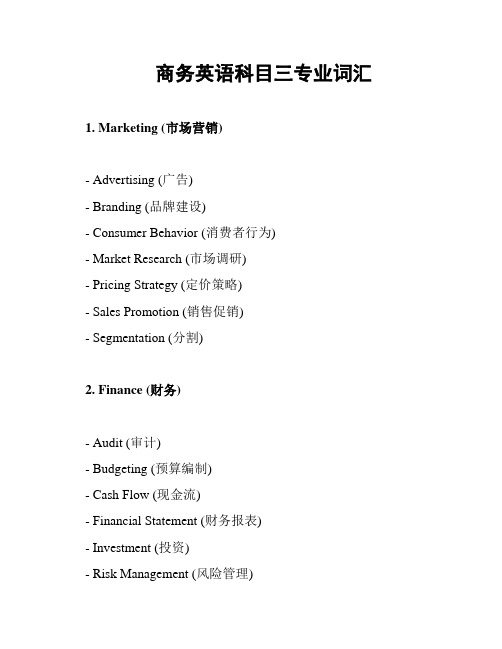
商务英语科目三专业词汇1. Marketing (市场营销)- Advertising (广告)- Branding (品牌建设)- Consumer Behavior (消费者行为)- Market Research (市场调研)- Pricing Strategy (定价策略)- Sales Promotion (销售促销)- Segmentation (分割)2. Finance (财务)- Audit (审计)- Budgeting (预算编制)- Cash Flow (现金流)- Financial Statement (财务报表)- Investment (投资)- Risk Management (风险管理)- Taxation (税务)3. International Business (国际商务)- Foreign Direct Investment (外国直接投资) - Globalization (全球化)- Import/Export (进出口)- Joint Venture (合资企业)- Trade Agreements (贸易协定)- World Trade Organization (世界贸易组织) 4. Human Resources (人力资源)- Employee Training (员工培训)- Labor Laws (劳动法)- Performance Evaluation (绩效评估)- Recruitment (招聘)- Salary Negotiation (薪资谈判)- Team Building (团队建设)- Workforce Diversity (劳动力多样化)5. Operations Management (运营管理)- Capacity Planning (产能规划)- Inventory Management (库存管理)- Lean Manufacturing (精益生产)- Quality Control (质量控制)- Supply Chain Management (供应链管理)- Time Management (时间管理)- Workflow Optimization (工作流优化)以上是商务英语科目三的一些专业词汇,涵盖了营销、财务、国际商务、人力资源和运营管理等领域的重要词汇。
商务英语市场营销重点名词解释

Chapter 1Marketing:t he process by which companies create value for customers and build strong customer relationships in order to capture value from customers in return.Marketing myopia营销短视:the mistake of paying more attention to the specific products a company offers rather than to the benefits and experiences produced by these products.Customer-perceived value: the customer’s evaluation of the differences between all the values and all costs of a marketing offer relative to those of competing offers.Customer satisfaction: the extent to which a product perceived performance matches the customer’s expectation.Customer equity: the total combined customer lifetime values of all of a company’s all customers.Chapter 2Strategic planning: the progress of developing and maintaining a strategic fit between a organization’s goals and capabilities and its changing marketing opportunities.Mission statement: a statement of a organization’s purpose—what it wants to accomplish in the larger environmentBusiness portfolio: t he collection of businesses and products that makesup the company以下四个和Chapter 7中的内容重复Market segmentation: dividing the market into distinct groups of buyers who might have different needs, characteristics and behavior, and who might require separate products or marketing programs.Market targeting: t he progress of evaluating each segment’s marketing attractiveness and selecting one or more segments to enter. Positioning: arranging for a product to occupy a clear, distinctive and desirable place relative to the competing products in the minds of the target customers.Differentiation: actually differentiating the market offering to create superior customer value.Chapter 3Marketing environment: the actors and forces outside the marketing that affect marketing management’s ability to build and maintain successful relationships with target customers.Microenvironment: the actors close to the company that affect its ability to serve its customers,--the company, suppliers, market customers, marketing intermediaries, competitors and publics.Macroenvironment: the larger societal forces that affect the microenvironment---demographic, natural, economic, political, technological and cultural forces.Marketing intermediaries: the forms that help the company to promote, sell and distribute its goods to final buyers.Chapter 5Consumer buyer behavior: the buying behavior of final consumers—the individuals and householders buy goods and services for personal consumptionConsumer market: all individuals and householders who buy or acquire goods and services for personal consumption.Subculture亚文化群:a group of people with shared value systems based on the common life experiences and situations.Opinion leader: a person within reference group who, because of special skills, knowledge, or other characteristics, exerts social influence on others.Complex buying behavior:consumer buying behavior in situations characterized by high consumer involvement in a purchase and significant perceived brand differences.Habitual buying behavior:consumer buying behavior in situations characterized by low consumer involvement and few significantly perceived brand differences.Purchase decision: the buyer’s decision about which brand or purchase. Postpurchase behavior购后行为:the stage of the buyer decision process in which consumers take further action after the purchase, based on their satisfaction or dissatisfaction.Chapter 7Market segmentation:dividing the market into distinct groups of buyers, who might have different needs, characteristics or behavior, who might require separate products and marketing programs.Market targeting: the process of evaluating each segment’s attractiveness and selecting one or more segments to enter. Differention: actually differentiating a market offering to create superior customer valueTarget market: a set of buyers sharing common needs or characteristics that the company decides to serve.Undifferentiated (mass)marketing: a market-coverage strategy in which a firm decides to ignore the market segment differences and go after the whole market with one offer.Differentiated (segmented)marketing:a market-coverage strategy in which a firm decides to target several market segments and design separate offer for each.Concentrated (niche) marketing: a market-coverage strategy in which afirm decides to go after a large share of one or a few segments or niches. Micromarketing: the practice of tailoring the products and marketing programs to the needs and wants of specific individuals and local customer groups—include individual marketing and local marketing. Competitive advantage: an advantage over competitors gained by offering greater customer value, either through lower prices or by providing more benefits that justify the high prices.Chapter 8Consumer product: a product bought by final consumer for personal consumption.Industrial product:a product bought by individuals and organizations for further processing or for use in conducting a business.Product line:a group of products that are closely related because they function in a similar manner, are sold to the customer group, are marketed through the same types of outlets, or fall within given price ranges. Product mix: the set of all product lines and items that a particular seller offers for sale.Brand equity: the differential effect that knowing the brand name has on customer response to the product or its marketing.Chapter 10Value-based pricing: setting price based on buyers’ perceptions of valuerather than on seller’ cost.Cost-based pricing: setting prices based on producing, distributing and selling the product plus a fair rate of return for effort and risk.Fixed costs : costs that do not vary with production or sales level. Variable costs: costs that directly vary with the level of production.Chapter 11Market-skimming pricing:setting a high price for a new product to skim maximum revenues layer by layer from the segments willing to pay the high price; the company makes fewer but more profitable sales. Market-penetration pricing:setting a low price for a new product to attract a larger number of buyers and a large market share.Chapter 12Value delivery network: the network made up of the company, suppliers, distributors and ultimately customers, who “partner”with each other to improve the performance of the entire system in delivering customer value.Marketing channel: a set of independent organizations that help the company make a product and service for use or consumption by the consumers or business users.Channel conflict: disagreement among marketing channel members ongoals and roles—who should do what and for what rewards.Vertical marketing system: a distribution channel structure in which the producers, wholesalers and retailers act as a unified system. One channel member owns the others, has contracts with them, or has so much power that they all cooperate.Chapter 14Promotion mix(marketing communications mix): the specific blend of promotion tools that the company uses to persuasively communicate customer value and build customer relationships.Integrated marketing communications:carefully integrating and coordinating the company’s many communications channels to deliver a clear, consistent and compelling message about the organizations and the products.Explain marketing’s role in strategic planning and how marketing works with its partners to create and deliver customer value.The major functional departments must work together to accomplish strategic objectives. Marketing plays a key role in the company’s strategic planning by providing a marketing concept philosophy and inputs regarding attractive market opportunities. Within individual businessunits, marketing designs strategies for reaching the unit’s objectives and help to carry them out profitably. Marketers alone cannot produce superior value for customers. A company’s success depends on how well each department performs its customer value-adding activities and how well the departments work together to serve customers. Marketers must practice partner relationship management. They must work closely with partners in other departments to form an effective value chain that serves the customers. And they must partner effectively with other companies in the marketing system to form a competitively superior value delivery network.Describe the elements of a customer-driven marketing strategy and mix, and the forces that influence it.Consumer value and relationships are at the centre of marketing strategy and programs. Through market segmentation, targeting, differentiation, and positioning, the company divides the market into smaller segments, selects segments it can best serve, and decides how it wants to bring value to target consumers. It then designs an integrated marketing mix to produce the response it wants in the target market. The marketing mix consists of product, price, place, and promotion decisions.Describe the environmental forces that affect the company’s ability to serve its customers’Definitions of microenvironment and macroenvironment.Describe the consumer market and construct a simple model of consumer buyer behavior.The simplest model is the stimulus-response model. According to this model, marketing stimuli and other major forces enter the consumer’s “black box” and produce certain responses. Once in the black box, these inputs produce observable buyer responses, such as product choice, brand choice, purchase timing, and purchase amount.Name the four major factors that influence consumer buyer behavior. Consumer buyer behavior is influenced by four key sets of buyer characteristics: cultural, social, personal, and psychological.Consumer buyer behavior is influenced by four major psychological factors—motivation, perception, learning, and beliefs and attitudes.?????184。
商务英语综合教程u1和u2商务词汇总结

商务英语综合教程u1和u2商务词汇总结以下是商务英语综合教程U1和U2中的一些商务词汇总结:1. Business Plan 商业计划2. Marketing 市场营销3. Product 产品4. Pricing 定价5. Distribution 分配6. Promotion 促销7. Customer Service 客户服务8. Brand 品牌9. Competition 竞争10. Strategy 策略11. Budget 预算12. Finance 财务13. Revenue 收入14. Profit 利润15. Loss 损失16. Expense 支出17. Inventory 库存18. Merger 合并19. Acquisition 收购20. Negotiation 谈判21. Contract 合约22. Leadership 领导力23. Teamwork 团队合作24. Communication 沟通25. Ethics 道德26. CSR 企业社会责任27. Strategy 战略28. Operations 管理29. Human Resources 人力资源30. Training 培训31. Recruitment 招聘32. Performance 绩效33. Retention 保留34. Organizational Culture 组织文化35. Change Management 变革管理36. Risk Management 风险管理37. Compliance 合规性38. Quality Management 质量管理39. Project Management 项目管理40. Supply Chain Management 供应链管理41. E-commerce 电子商务42. Social Media 社交媒体43. Digital Marketing 数字营销44. Data Analysis 数据分析45. Big Data 大数据46. Cloud Computing 云计算47. Mobile Commerce 移动商务48. IoT Internet of Things 万物互联49. AI Artificial Intelligence 人工智能50. PEST Analysis PEST分析(政治、经济、社会、科技)51. SWOT Analysis SWOT分析(优势、劣势、机会、威胁)52. Porter’s Five Forces Analysis 五力模型分析(供应商、购买者、新进入者、替代品、现有竞争对手)53. BCG Matrix (Boston Consulting Group Matrix) BCG矩阵(波士顿矩阵)54. Portfolio Management 投资组合管理55. Blue Ocean Strategy 蓝海战略56. Value Chain Analysis 价值链分析法57. Cost Leadership Strategy 低成本战略(成本领先战略)58. Differentiation Strategy 差异化战略(别具一格战略)59. Focus Strategy 集中化战略(目标集聚战略)60. Positioning Strategy 市场定位战略(市场利基战略)61. Pestle Analysis PESTLE分析(政治、经济、社会、技术、法律和环境)62. Porters Generic Strategies Porter的通用战略(总成本领先、差异化、专一化)等。
商务英语词汇大全
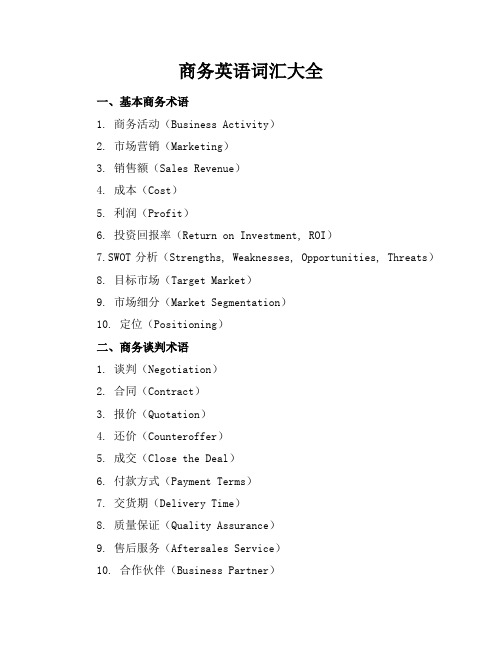
商务英语词汇大全一、基本商务术语1. 商务活动(Business Activity)2. 市场营销(Marketing)3. 销售额(Sales Revenue)4. 成本(Cost)5. 利润(Profit)6. 投资回报率(Return on Investment, ROI)7.SWOT分析(Strengths, Weaknesses, Opportunities, Threats)8. 目标市场(Target Market)9. 市场细分(Market Segmentation)10. 定位(Positioning)二、商务谈判术语1. 谈判(Negotiation)2. 合同(Contract)3. 报价(Quotation)4. 还价(Counteroffer)5. 成交(Close the Deal)6. 付款方式(Payment Terms)7. 交货期(Delivery Time)8. 质量保证(Quality Assurance)9. 售后服务(Aftersales Service)10. 合作伙伴(Business Partner)三、商务函电术语1. 询盘(Inquiry)2. 报盘(Offer)3. 订单(Order)4. 发票(Invoice)5. 装箱单(Packing List)6. 信用证(Letter of Credit, L/C)7. 汇票(Bill of Exchange)8. 托运单(Shipping Order)9. 提单(Bill of Lading)10. 保险(Insurance)四、人力资源术语1. 招聘(Recruitment)2. 简历(Resume)3. 面试(Interview)4. 培训(Training)5. 薪资(Salary)6. 福利(Benefits)7. 绩效考核(Performance Appraisal)8. 晋升(Promotion)9. 劳动合同(Labor Contract)10. 职业规划(Career Planning)五、企业运营术语1. 企业战略(Corporate Strategy)2. 企业文化(Corporate Culture)3. 组织结构(Organizational Structure)4. 部门(Department)5. 团队协作(Teamwork)6. 项目管理(Project Management)7. 生产计划(Production Plan)8. 供应链管理(Supply Chain Management)9. 库存(Inventory)10. 客户关系管理(Customer Relationship Management, CRM)六、财务与会计术语1. 财务报表(Financial Statements)2. 资产(Assets)3. 负债(Liabilities)4. 所有者权益(Owner's Equity)5. 现金流(Cash Flow)7. 资产负债表(Balance Sheet)8. 利润分配(Profit Distribution)9. 折旧(Depreciation)10. 纳税(Taxation)七、国际贸易术语1. 进口(Import)2. 出口(Export)3. 贸易壁垒(Trade Barrier)4. 关税(Tariff)5. 配额(Quota)6. 原产地证明(Certificate of Origin)7. 贸易术语(Trade Terms,如FOB、CIF等)8. 国际支付(International Payment)9. 外汇(Foreign Exchange)10. 世界贸易组织(World Trade Organization, WTO)八、市场营销策略术语1. 市场调研(Market Research)2. 产品生命周期(Product Life Cycle)3. 广告(Advertising)4. 促销(Promotion)5. 公关(Public Relations)6. 品牌战略(Brand Strategy)7. 网络营销(Internet Marketing)8. 社交媒体营销(Social Media Marketing)9. 客户满意度(Customer Satisfaction)10. 忠诚度计划(Loyalty Program)九、企业管理术语1. 领导力(Leadership)2. 决策(Decision Making)3. 风险管理(Risk Management)4. 企业伦理(Business Ethics)5. 知识管理(Knowledge Management)6. 创新能力(Innovation Capability)7. 企业形象(Corporate Image)8. 危机管理(Crisis Management)9. 持续改进(Continuous Improvement)10. 企业社会责任(Corporate Social Responsibility, CSR)十、电子商务术语2. 在线支付(Online Payment)3. 网络安全(Network Security)4. 顾客评价(Customer Review)6. 网络营销策略(Online Marketing Strategy)7. 搜索引擎优化(Search Engine Optimization, SEO)8. 率(Clickthrough Rate, CTR)9. 转化率(Conversion Rate)通过这些词汇的积累,您将能够在商务交流中更加得心应手,展现出您的专业素养和沟通能力。
商务英语基础教程(一)
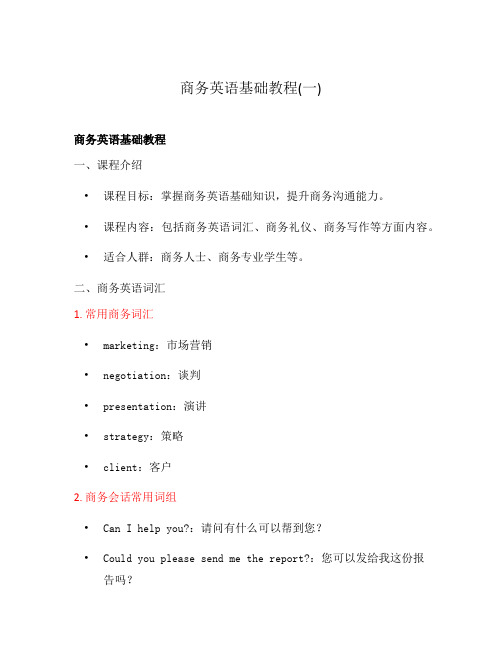
商务英语基础教程(一)
商务英语基础教程
一、课程介绍
•课程目标:掌握商务英语基础知识,提升商务沟通能力。
•课程内容:包括商务英语词汇、商务礼仪、商务写作等方面内容。
•适合人群:商务人士、商务专业学生等。
二、商务英语词汇
1. 常用商务词汇
•marketing:市场营销
•negotiation:谈判
•presentation:演讲
•strategy:策略
•client:客户
2. 商务会话常用词组
•Can I help you?:请问有什么可以帮到您?
•Could you please send me the report?:您可以发给我这份报告吗?
•I’m sorry, I don’t understand.:对不起,我不明白。
三、商务礼仪
1. 商务会议礼仪
•准时出席会议,注意穿着得体。
•在会议中保持礼貌和尊重,不打断他人发言。
•注意对应礼节,如握手、鞠躬等。
2. 商务邮件礼仪
•使用明确的主题,简明扼要地写邮件内容。
•注意语气礼貌,使用正式的称呼。
•确保邮件中没有拼写和语法错误。
四、商务写作
1. 商务报告写作
•确定报告的结构,包括引言、正文和结论。
•使用简明扼要的语言,清晰表达观点。
•包括数据和图表来支持观点。
2. 商务演讲写作
•确定演讲的目标和主题。
•编写演讲稿,注意结构和逻辑性。
•练习演讲,确保流利和自信。
以上是商务英语基础教程的主要内容概述,通过系统学习和实践,您将能够提升商务英语能力,更好地应对商务场景。
商务英语(市场营销专业英语)课程教学大纲
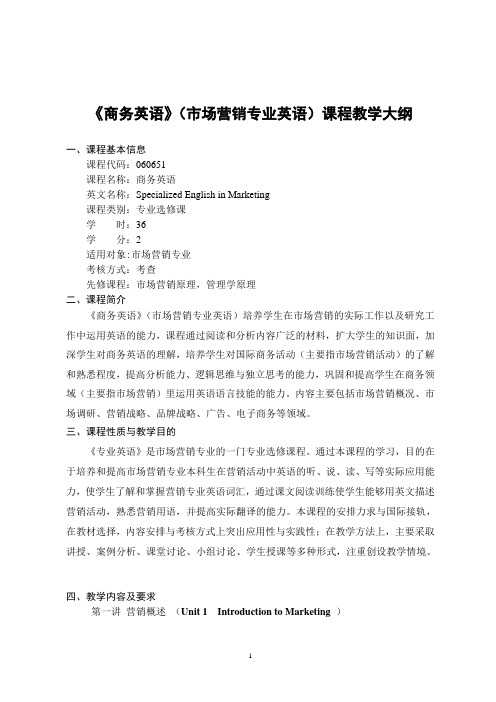
《商务英语》(市场营销专业英语)课程教学大纲一、课程基本信息课程代码:060651课程名称:商务英语英文名称:Specialized English in Marketing课程类别:专业选修课学时:36学分:2适用对象:市场营销专业考核方式:考查先修课程:市场营销原理,管理学原理二、课程简介《商务英语》(市场营销专业英语)培养学生在市场营销的实际工作以及研究工作中运用英语的能力,课程通过阅读和分析内容广泛的材料,扩大学生的知识面,加深学生对商务英语的理解,培养学生对国际商务活动(主要指市场营销活动)的了解和熟悉程度,提高分析能力、逻辑思维与独立思考的能力,巩固和提高学生在商务领域(主要指市场营销)里运用英语语言技能的能力。
内容主要包括市场营销概况、市场调研、营销战略、品牌战略、广告、电子商务等领域。
三、课程性质与教学目的《专业英语》是市场营销专业的一门专业选修课程。
通过本课程的学习,目的在于培养和提高市场营销专业本科生在营销活动中英语的听、说、读、写等实际应用能力,使学生了解和掌握营销专业英语词汇,通过课文阅读训练使学生能够用英文描述营销活动,熟悉营销用语,并提高实际翻译的能力。
本课程的安排力求与国际接轨,在教材选择,内容安排与考核方式上突出应用性与实践性;在教学方法上,主要采取讲授、案例分析、课堂讨论、小组讨论、学生授课等多种形式,注重创设教学情境。
四、教学内容及要求第一讲营销概述(Unit 1 Introduction to Marketing)(一)目的与要求1.本讲要求学生掌握市场营销的一些基本概念,如市场营销、市场营销战略、4P等;2.要求熟悉市场营销的历史发展阶段;3.要求了解市场营销每个历史发展阶段的特点。
(二)教学内容1.主要内容:1)S ome concepts in marketing;2)The evolution of marketing:production era,sales era, marketing era, relationship marketing era3)Case study: strategic issues in Chinese marketing2.基本概念和知识点:基本概念:marketing,marketing strategy,position,segmentation,target market, 4Ps(product, place, price, promotion ), brand value知识点:have some knowledge of the 4Ps in Chinese market3.问题与应用(能力要求): 无。
世纪商务英语综合教程三 第四版 Unit 4 Marketing

maker 2. An American T-shirt ____________ in Miami printed shirts for the Spanish market which _____________ the Pope’s visit. Instead of “I saw the promoted _________” (el papa), the shirts read “I saw the ___________” (la papa). potato Pope
and distribution.
Unit 4
Marketing
Text A
Tape Script
The Marketing Concept
5 There are many different definitions of marketing. Consider some of the The all-embracing function that links the business with customers’ needs and wants in order to get the right product to the right place at the right time; The achievement of corporate goals through meeting and exceeding customers’ needs better than the competition; The management process that identifies, anticipates and supplies customers’ requirements efficiently and profitably;
商务英语Marketing
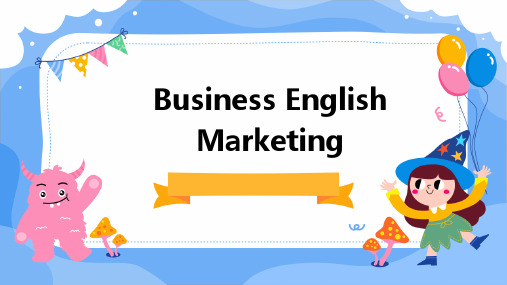
Definition and Importance of Marketing
Marketing is the process of planning and executing the concept, pricing, promotion, and distribution of ideas, goods, and services to create exchanges that satisfy individual and organizational objectives
Developing a comprehensive product line plan that includes pricing, promotion, and distribution strategies
Evaluating the potential for product line extensions or variations to meet diverse customer demands
VS
Marketing is important because it helps organizations understand customer needs, build brand awareness, different products or services, and ultimately drive sales and revenue
skills
目录
• Promotion and advertising strategies • Customer Relationship Management and
Service Improvement
01
Basic Concepts and Principles of Marketing
【商务英语】市场营销(中英)

1.Marketing 市场营销:通过方案和执行关于产物、效劳和电子的订价、促销和分销,从而缔造交换,以实现个人和组织的目标的过程〕The process of planning and executing 〔执行、实行〕the conception, pricing, promotion, and distribution of goods, services and ideas to create exchanges that satisfy individual and organizational objectives.——the definition emphasizes the diverse activities marketers perform.(强调市场商人不同的行为活动)❖Deciding what products to offer❖Setting prices❖Developing sales promotions and advertising campaigns❖Making products readily available to customers2. The marketing Concepts(市场营销不雅念:企业阐发消费者需求,制定比竞争对后更好的决策来满足这些需求的哲学)❖The Production Concept 出产不雅念❖The Selling Concept 推销不雅念❖The Marketing Concept 市场营销不雅念The Production Concept 出产不雅念The idea that a firm should focus on those products that it could produce most efficiently and that the low-cost products would create the demand for those products.The Selling Concept / sales concept 推销不雅念(操纵广告这种重要方式来与其顾客沟通从而获取他们的订单)The Marketing Concept市场营销不雅念Difference between Selling and Marketing发卖与营销的区别3.The Marketing Mix / The 4P’s of Marketing市场营销组合1)Product〔产物:有形和无形,包罗包装、色彩、品牌、效劳,甚至发卖商的声誉〕Consumer products消费品:produced for and purchased byhouseholds for their use.Industrial products 工业产物:are sold primarily for use inproducing other products.2)Price〔价格:消费者为获得产物所必需支付的金额〕Refers to the value or worth of a product that attracts the buyer to exchange money or something of value for the product.Loss Leader Pricing(亏本出售商品〕selling things in its lower price than its cost price in order to attract customers to purchase the products.Penetration Pricing (渗透订价法---心理订价策略〕设定最初低价,以便迅速和深入地进入市场,从而快速吸引来大量的购置者,博得较大的市场份赖。
商务英语unit4 Marketing
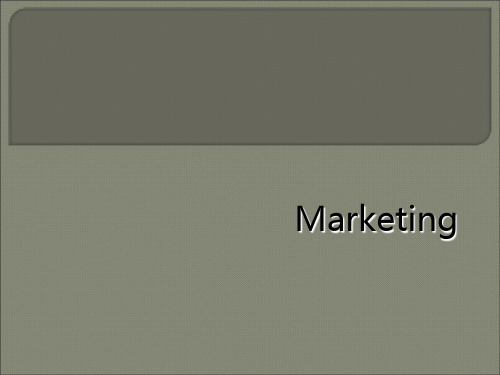
Could you define the following concepts?
Market segment is a group of consumers who respond in a similar way to a given set of marketing efforts
Target marketing is the process of evaluating each market segment’s attractiveness and selecting one or more segments to enter
Selling Co buy products only if the company promotes/ sells these product
Marketing Concept
Societal Marketing Concept
• Focuses on needs/ wants of target markets and delivering satisfaction better than competitors
Marketing mix is the set of controllable tactical marketing tools
Introduction of Xiaomi
• privately owned Chinese electronics company
• headquartered in Beijing China.
Marketing Management
Marketing management is “the art and
science of choosing target markets and building profitable relationships with them.”
商务英语视听说课程unitmarketing

Theoverall concept of product
PotentialProduct
AugmentedProduct ExpectedProduct ActualProduct CoreProduct
❖ Examplefor NongFu Spring
Alittle sweet taste Mineral water Mineralwater from the Qiandao Lake
definitions a to d
一Product 二 Price 三 Promotion 四 Place
athe cost to the buyer of goods or services
b informing customers about products and persuading them to buy them
A ‘Thefour Ps’ form the basis of the marketing mix. If you want to market a product successfully, you need to get this mix right. Match the ‘Ps’ 一 to 四 to the
Place: channels of distribution and timely
transportation, make goods and services availableБайду номын сангаас
分销策略:将产品和服务及时送达到消费者手中的渠道 和路径
OralPractice
Discuss in pairs. What is the most expensive product you bought in the past half year Why did you buy it? Was it strongly or weakly marketed?
- 1、下载文档前请自行甄别文档内容的完整性,平台不提供额外的编辑、内容补充、找答案等附加服务。
- 2、"仅部分预览"的文档,不可在线预览部分如存在完整性等问题,可反馈申请退款(可完整预览的文档不适用该条件!)。
- 3、如文档侵犯您的权益,请联系客服反馈,我们会尽快为您处理(人工客服工作时间:9:00-18:30)。
Buyer Behavior Marketing Research Market Segmentation
Case Study
Contents two
What Is Marketing?
由湖南卫视与蒙牛乳业联手推出的这一活动,在 2005年让亿万中国人兴奋不已。AC尼尔森的调查 显示,2005年6月蒙牛酸酸乳在广州、上海、北 京、成都四城市的销售超过100百万公升,是 2004年同期的5倍。 点评:位居“2005年度中国九大营销案例策划案” 榜首,“超级女声”是众望所归。其成功不仅在 于产品和宣传形式的创新,还在于它通过低成本 运作获得了轰动效应,一个电视节目带动企业产 品、节目生产者、移动运营商、“超女”本人四 者共赢,实现了销售系统和媒介系统的完美整合。
It has to You have to
be
tell people
available about it
2005年“五·一”假期,一群商务精英聚集敦煌, 组成了两个勇敢者队伍,每人携带一部飞利
浦手机作为唯一的通信工具和摄影工具,开始了 为期六天的“商务精英野外生存挑战赛”。七 月,类似的活动又在新疆北部的喀纳斯举行。
The Product Life Cycle
INTRODUCTION PHASE GROWTH PHASE MATURITY PHASE DECLINE PHASE
LIMITATIONS OF THE PRODUCT LIFE CYCLE CONCEPT
The Product Life Cycle
优秀PPT下载:www.1p pt.co m/ xiazai/
PPT教程: /powerpoint/
Word教程: /word/
Excel教程:www.1ppt.c om/excel/
资料下载:www. 1ppt.co m/zilia o/
PPT课件下载:www.1p pt.co m/ kejian/
3
The marketing concept
2005年4月,可口可乐(中国)与第九城市在上海签署了 跨领域推广《魔兽世界》的协议,开创饮料公司联手 网游公司的先河。“饮料+网游”这一跨行业合作营 销模式,带来新的消费群拓展模式。
点评:行业巨头之间的“异同合作、共生营销”,是 近年来企业普遍采取的一种营销策略,但关键前提是 合作企业之间的产品应该具有良好的互补性和相关性。 可口可乐和第(续致信网上一页内容)九城市利用了双 方的目标消费群体一致,看准游戏玩乐者的消费习惯 进行异业营销,追求双赢。娃哈哈、百事可乐等饮料 企业事后的模仿,更说明其模式的成功。
————(Approved July 2013) 美国市场营销协会 (American Marketing Association , AMA)
The Marketing Concept
The Marketing Concept
1
The production concept
2
Theing Mix (The Four p’s of Marketing
The Marketing Mix
1.
2.
3.
4.
Product:
Price:
It is more than you
think
It is important
to success
Place:
Promotion:
The Marketing Concept
Difference between selling and marketing
selling
•1.Emphasis is on the product •2.A company first makes the product and then figures out how to sell it •3.management is salesvolume oriented. •4.planning is short-run , in terms of today’s products and markets •5.It stresses the needs of the seller.
chapter
Marketing
市场营销
member:宁红霞 张强 王涛 张询 杨倩 高文奇
Contents one
What is Marketing? The Marketing Concept The Marketing Mix (The Four p’s of Marketing The Product Life Cycle
marketing
1.Emphasis is on customers’ needs 2.A company first determines customers’needs and then figures out how to make and deliver a product to satisfy those needs 3.Management is profit-oriented 4.Palanning is long-term, in the sense of new products, tomorrow’s markets, and future growth. 5.It stresses the needs of buyers
2005年4月,百胜集团在徐家汇开出了第一家中式快餐 店“东方既白”,取名源自苏东坡的“不知东方之既 白”。2005年8月,肯德基针对“传统洋快餐产品选择 少,难以达到营养平衡”的软肋,在16个城市提出“拒 做传统洋快餐,全力打造符合中国国情的新快餐”的口 号。随后,1500家肯德基餐厅推出全新的“蔬果搭配 餐”。 点评:这是2005年跨国公司在华真正实践“本土化”的 营销案例策划。快餐的“快”和中式的“中”是其营销 的关键点。这是百胜将自己在西式快餐中掌握的窍门及 供应管理体系,结合本土饮食习惯,打出新的品牌。
点评:飞利浦的这一营销案例策划,可以说是宣 传“独特的销售主张”的成功案例。通过对目 标消费者——商务人士野外生存能力的考验,反 映了飞利浦手机超常的待机、耐磨、抗低温的 性能,宣传了自身的独特卖点;又赚了公众的“眼 球”。可以说,这是一个成功的体验营销案, 也是一个很好的公关策划案。
The Product Life Cycle
范文下载:www. 1ppt.co m/fan wen/
试卷下载:www.1ppt.c om/shiti /
教案下载:www. 1ppt.co m/jiao an/
PPT论坛:www.1ppt .cn
Marketing is the activity, set of institutions, and processes for creating, communicating, delivering, and exchanging offerings that have value for customers, clients, partners, and society at large.
What Is Marketing?
PPT模板下载:/moban/ 行业PPT模板:/hangye/
节日PPT模板:www.1p pt.co m/ jieri/
PPT素材下载:/sucai/
PPT背景图片:/beijing/ PPT图表下载:/tubiao/
